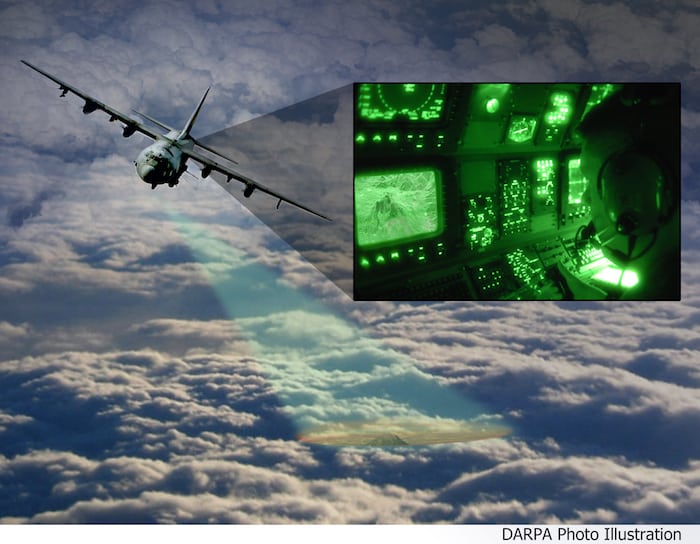
Video Synthetic Aperture Radar concept of operations. Image courtesy of DARPA
Soldiers slogging it out on the ground will get a much-needed boost when Video Synthetic Aperture Radar (ViSAR) technology takes the field. The miniaturized extremely high-frequency band (EHF) sensor, developed by the Defense Advanced Research Projects Agency (DARPA), promises uninterrupted imaging of moving and stationary ground targets when sensors are blinded by the dust and smoke of battle or when clouds obscure their view.
Now a flight-tested prototype, ViSAR aims to close these gaps and provide tactical situational awareness — targeting information and battle damage assessment — throughout an engagement. The problem with close air support today is that, once an engagement starts, the aircraft can’t see. AC-130 gunships, for example, typically use infrared (IR) sensors to target and engage maneuvering forces on the ground.
But once an action begins, “infrared sensors are unable to image through the dust caused by explosions and incoming rounds,” according to the ViSAR broad area announcement (BAA) dated Dec. 19, 2012.
Achievements
The program’s biggest achievement was the physical implementation of a working prototype that fits into a compact tactical gimbal, known as the Multi-Spectral Targeting System-B (MTS-B), said George Nowak, ViSAR program manager in DARPA’s strategic technology office. DARPA also had to develop hardware and image-processing software that works at the high end of the EHF band, which extends from 30 to 300 GHz. Northrop Grumman developed the exciter subsystem, L3 the high power amplifier, and Technical Service Corp. the processing algorithms, while Raytheon was the systems integrator.
DARPA has not publicly identified which military aircraft will be first to try ViSAR technology as it cycles through further development and testing and into the field. But the agency said that eligible platforms will host a complete battle management system capable of real-time target engagement as well as the 20-inch-diameter, moveable electro-optical/IR MTS-B gimbal or a gimbal of similar size. The BAA cited the AC-130 gunship as the “primary transition path for this effort.”
But the DC-3 flight test — to proof SAR electronics, pointing, data collection and processing systems — used geometries that are relevant to a range of potential transition platforms, Nowak said. The BAA language, he clarified, was “intended to provide guidance to potential bidders as to the desired form factor and size of the system.” Although the ViSAR development program concluded at the end of 2017, DARPA continues to tweak the design to improve the data presentation so visualization gets closer to the “natural” visualization provided by electro-optical and IR sensors, Nowak said.
Future automatic target recognition and datalink applications may also be possible.
Tradeoffs
The ViSAR sensor operates at 235 GHz over a tunable band of multiple GHz in the EHF band rather than the X band (7-11.2 GHz), where SAR radars typically operate, Nowak said. The higher frequency allows for a smaller antenna — as antenna size scales directly with wavelength — as well as higher frame rates and lower processing latencies. Compared to lower-frequency, longer-wavelength systems, EHF systems are also higher in resolution, but are shorter in range for a given power.
Other range factors include the sensitivity of the receiver and atmospheric effects at certain frequencies, as radio frequency (RF) energy is absorbed by gases in the air. An earlier ViSAR BAA asked for a frame rate greater than 5 Hz, or five times per second, and at least 0.2-meter resolution. However, the goal was to provide the best frame rate possible, balancing factors such as transmitter power, receiver sensitivity, frequency of operation and resolution, Nowak said.
DARPA was not out to match full-motion video, he added.
Flight Tests
A ViSAR prototype was flight-tested on a modified DC-3 last year, using an MTS-B standard gimbal that is employed by many aircraft, including drones. “The technology is more near-term than out there,” Nowak said. He rates the prototype at a technology readiness level of “about a six.” (A “nine” means that the performance of the sensor, in its final form, has been verified under mission-like conditions.)
The flight tests proved “that we can take uninterrupted live video of targets on the ground even when flying through or above clouds,” said former program manager, Bruce Wallace, in a DARPA release. “The EO/IR sensors on board the test aircraft went blank whenever clouds obscured the view, but the synthetic aperture radar tracked ground objects continuously throughout the flight.”
Wallace added that cloud-penetrating radars — such as from space or other operational systems — have existed in other formats, but that there has not been a synthetic aperture sensor that fits in a standard aircraft gimbal and maintains frame rates that are fast enough to track maneuvering targets on the ground. The DC-3 flight test aircraft flew at low and medium altitudes, allowing researchers to collect and compare data from the ViSAR, EO and IR sensors mounted on standard sensor gimbals, the agency said.
According to the abstract of a recent IEEE paper, the test results “produced exceptional SAR imagery and ground moving target indicator (GMTI) detections to validate many model-based assumptions about the operation and RF performance in this frequency band.”
“If the radar provides resolution and sees through clouds and other obscurants, it gives additional capability for insights into conditions in a potential area of operation,” such as the presence of troops and equipment, Nowak said.